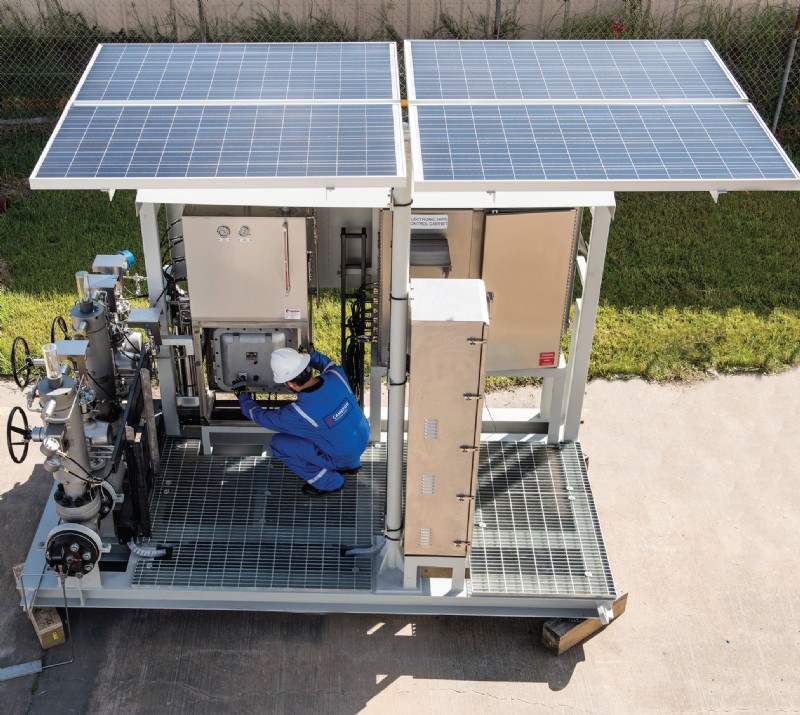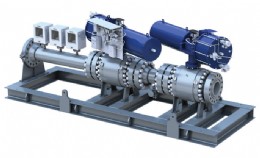Total Lifecycle Approach to HIPPS Provides Reliable Pressure Protection for Downstream Systems
HIPPS lifecycle management ensures optimal functionality in an emergency

A Schlumberger expert prepares the HIPPS prior to testing. (Image courtesy of Schlumberger)

Suitable for onshore and offshore installations requiring high-integrity pressure protection of downstream systems, HIPPS is used to prevent a system from exceeding its rated pressure level. (Image courtesy of Schlumberger)
HIPPS are safety instrumented systems (SIS) having a primary function to detect high- or low-pressure scenarios, and, through the fast acting operation of the final elements (valves), isolate the pipeline to protect the lower-pressure-rated downstream infrastructure. These systems are designed in accordance with the IEC 61508 and IEC 61511 functional safety standards and replace other traditional high-cost pressure relief and flare systems that have the disadvantage of releasing media to the atmosphere. The systems typically operate autonomously and are independent of the facilities process shutdown (PSD), emergency shutdown (ESD), or control systems. HIPPS are failclose by design and include redundancies that reduce the risk of failure on demand and maximize availability for operators.
Evolution to fully electronic systems
In 1985 the first safety shutdown valve (SSV) was installed by Cameron (now a Schlumberger company) and since then has evolved to skid-mounted mechanical HIPPS packages and now to fully electronic systems. Of the more than 200+ installed systems, many are high-pressure systems for production facilities. SIL 3-certified, HIPPS can be provided in a variety of configurations, including mechanical and electronic skid-mounted packages. The system incorporates final elements, such as the FLS* extreme service API 6A slab-style gate valves and GROVE* valves manufactured to API 6A/6D for critical service. Pneumatic and hydraulic actuation and control options are available depending on requirements.
A lifecycle approach to HIPPS
Given the importance of selecting, designing, manufacturing, and operating the optimal safety system for each application, Schlumberger promotes following a complete lifecycle management approach to maximize customer value from HIPPS. This starts from the frontend design phase where it is critical to have early engagement in identifying the most cost-effective HIPPS design for the application. Engaging design experts upfront helps ensure the system design meets the functional Safety Requirements Specification (SRS) while minimizing proof testing and service requirements.
Once the functional safety inputs are defined, a multi-disciplined team of engineers and certified safety professionals design the HIPPS using a combination of patented in-house technology and high-quality components with the objective of achieving maximum performance from the safety system. Manufacturing is then executed in accordance with the company’s industry leading standards. With the company’s extensive service footprint, system integration and installation can be performed where it is most valuable for the customer including onsite when size and weight limitations exist. Commissioning and validation must be completed in accordance with the manufacturer’s requirements. Project on-time delivery is key and a dedicated team will manage the complete execution process.
In accordance with IEC 61511, HIPPS must be periodically proof tested in order to maintain the safety integrity level (SIL) rating. Smart diagnostics can be installed on the system to perform intermediate health checks between service intervals without shutting down production. Partial stroke testing can help to verify system functionality; however, operators should be aware that it only grants partial proof test coverage as not all elements of the system are tested. The partial and full proof test intervals are established in the design phase. IEC standards require the effectiveness of the proof testing to be documented and only then can operators maintain the SIL rating. Performing the necessary verifications of the HIPPS is essential in ensuring it will respond in a real emergency situation. Schlumberger focuses on minimizing downtime and supports customers in performing system proof testing and service work.
Following the above total lifecycle approach ultimately leads to a system that is designed, manufactured, and maintained with safety as a priority. This ultimately reduces total cost of ownership for the operator and maximizes dependable functionality of the safety system.
*Mark of Schlumberger

| Telephone: | 01224 982000 |
| Email: | SMowatt@slb.com |
| Website: | www.products.slb.com/valves |
| More information on the Cameron, a Schlumberger Company BVAA Member Directory Page |
Search related valve / actuator articles: Cameron, a Schlumberger CompanyIssue 41Safety and StandardsTestingSystem ControlWirelessTransmittersFieldbusProximity SwitchesControl PanelsPositioners







-web.jpg)





